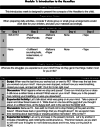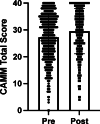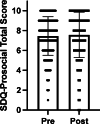A Large-Scale Naturalistic Evaluation of the AIM Curriculum in a Public-School Setting
- PMID: 35340376
- PMCID: PMC8854521
- DOI: 10.1007/s40617-021-00569-5
A Large-Scale Naturalistic Evaluation of the AIM Curriculum in a Public-School Setting
Erratum in
-
Correction to: A Large-Scale Naturalistic Evaluation of the AIM Curriculum in a Public-School Setting.Behav Anal Pract. 2021 Dec 9;15(1):171. doi: 10.1007/s40617-021-00676-3. eCollection 2022 Mar. Behav Anal Pract. 2021. PMID: 35344317 Free PMC article.
Abstract
This study evaluated the effectiveness of the AIM curriculum when implemented in a public-school setting by schoolteachers and direct care staff. Three hundred eighteen students took part in this quasiexperimental design where all received the AIM curriculum every day for an entire school year. The participants completed a series of self-assessments (the Avoidance and Fusion Questionnaire for Youth, the Child and Adolescent Mindfulness Measure, and the Strength and Difficulties Questionnaire) at the onset of the study and at the end of the school year to assess psychological flexibility, mindfulness, and emotional behavioral skills. Results suggest that at the end of the school year, participants increased psychological flexibility and mindfulness. State standardized testing scores also showed increases school-wide as compared to the previous 2 years. These results suggest that the AIM curriculum may be effective in large school settings, appeared easy to implement by school staff to address the needs of both the individual student and the entire student body, and likely participated in improving school-wide academic success.
Keywords: ACT Therapy; AIM; Mindfulness; Psychological flexibility; Public education; State testing.
© Association for Behavior Analysis International 2021.
Conflict of interest statement
Conflict of interestMark R. Dixon and Dana Paliliunas receive small royalties from the sales of the AIM curriculum.
Figures









References
-
- Bradshaw CP, Bottiani JH, Osher D, Sugai G. The integration of positive behavioral interventions and supports and social and emotional learning. In: Weist M, Lever N, Bradshaw C, Owens J, editors. Handbook of school mental health. Issues in clinical child psychology. Springer; 2014. pp. 101–118.
-
- Center for Wellness & Achievement in Education & SFUSD Research, Planning, & Accountability Department. (2015). CWAE quiet time program data report. Retrieved from http://www.cwae.org/whitepaper/
LinkOut - more resources
Full Text Sources

